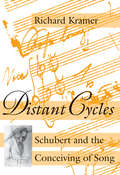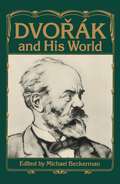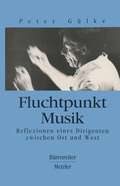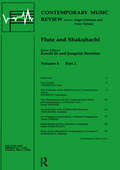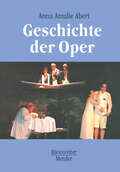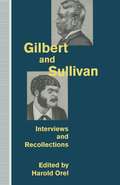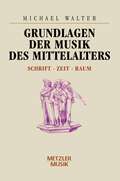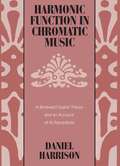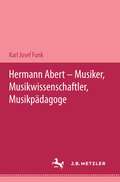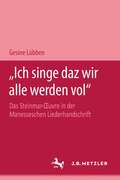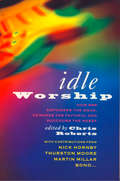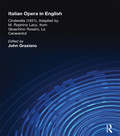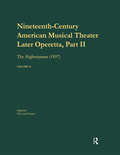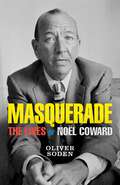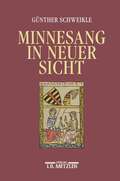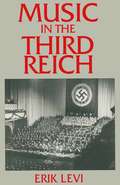- Table View
- List View
Distant Cycles: Schubert and the Conceiving of Song
by Richard KramerFranz Schubert's song cycles Schone Mullerin and Winterreise are cornerstones of the genre. But as Richard Kramer argues in this book, Schubert envisioned many other songs as components of cyclical arrangements that were never published as such. By carefully studying Schubert's original manuscripts, Kramer recovers some of these "distant cycles" and accounts for idiosyncrasies in the songs which other analyses have failed to explain. Returning the songs to their original keys, Kramer reveals linkages among songs which were often obscured as Schubert readied his compositions for publication. His analysis thus conveys even familiar songs in fresh contexts that will affect performance, interpretation, and criticism. After addressing problems of multiple settings and revisions, Kramer presents a series of briefs for the reconfiguring of sets of songs to poems by Goethe, Rellstab, and Heine. He deconstructs Winterreise, using its convoluted origins to illuminate its textual contradictions. Finally, Kramer scrutinizes settings from the Abendrote cycle (on poems by Friedrich Schlegel) for signs of cyclic process. Probing the farthest reaches of Schubert's engagement with the poetics of lieder, Distant Cycles exposes tensions between Schubert the composer and Schubert the merchant-entrepreneur.
Dvorák and His World (The Bard Music Festival #31)
by Michael BeckermanAntonin Dvorák made his famous trip to the United States one hundred years ago, but despite an enormous amount of attention from scholars and critics since that time, he remains an elusive figure. Comprising both interpretive essays and a selection of fascinating documents that bear on Dvorák's career and music, this volume addresses fundamental questions about the composer while presenting an argument for a radical reappraisal. The essays, which make up the first part of the book, begin with Leon Botstein's inquiry into the reception of Dvorák's work in German-speaking Europe, in England, and in America. Commenting on the relationship between Dvorák and Brahms, David Beveridge offers the first detailed portrait of perhaps the most interesting artistic friendship of the era. Joseph Horowitz explores the context in which the "New World" Symphony was premiered a century ago, offering an absorbing account of New York musical life at that time. In discussing Dvorák as a composer of operas, Jan Smaczny provides an unexpected slant on the widely held view of him as a "nationalist" composer. Michael Beckerman further investigates this view of Dvorák by raising the question of the role nationalism played in music of the nineteenth century. The second part of this volume presents Dvorák's correspondence and reminiscences as well as unpublished reviews and criticism from the Czech press. It includes a series of documents from the composer's American years, a translation of the review of Rusalka's premiere with the photographs that accompanied the article, and Janácek's analyses of the symphonic poems. Many of these documents are published in English for the first time.
Dvorák and His World (PDF)
by Michael BeckermanAntonin Dvorák made his famous trip to the United States one hundred years ago, but despite an enormous amount of attention from scholars and critics since that time, he remains an elusive figure. Comprising both interpretive essays and a selection of fascinating documents that bear on Dvorák's career and music, this volume addresses fundamental questions about the composer while presenting an argument for a radical reappraisal. The essays, which make up the first part of the book, begin with Leon Botstein's inquiry into the reception of Dvorák's work in German-speaking Europe, in England, and in America. Commenting on the relationship between Dvorák and Brahms, David Beveridge offers the first detailed portrait of perhaps the most interesting artistic friendship of the era. Joseph Horowitz explores the context in which the "New World" Symphony was premiered a century ago, offering an absorbing account of New York musical life at that time. In discussing Dvorák as a composer of operas, Jan Smaczny provides an unexpected slant on the widely held view of him as a "nationalist" composer. Michael Beckerman further investigates this view of Dvorák by raising the question of the role nationalism played in music of the nineteenth century. The second part of this volume presents Dvorák's correspondence and reminiscences as well as unpublished reviews and criticism from the Czech press. It includes a series of documents from the composer's American years, a translation of the review of Rusalka's premiere with the photographs that accompanied the article, and Janácek's analyses of the symphonic poems. Many of these documents are published in English for the first time.
Fluchtpunkt Musik: Reflexionen eines Dirigenten zwischen Ost und West
by Peter GülkeReflexionen eines Dirigenten zwischen Ost und West.
Flute and Shakuhachi (Contemporary Music Review)
by Kondō Jō Joaquim BernítezFirst Published in 1994. In their quest for new sound materials, avant-garde musicians often produce sounds which accidentally bear a strong resemblance to traditional instruments. While conventional Western instruments have taken on a functional role, instruments such as the shakuhachi are still closely associated with their cultural, religious, and historical roots. The colorful and unique shakuhachi has become the most widely known and used Japanese instrument. This collection provides a comprehensive historical overview of the shakuhachi, its technical aspects and its relationship to the flute.
Flute and Shakuhachi (Contemporary Music Review)
by Jo Kondo J BenitezFirst Published in 1994. In their quest for new sound materials, avant-garde musicians often produce sounds which accidentally bear a strong resemblance to traditional instruments. While conventional Western instruments have taken on a functional role, instruments such as the shakuhachi are still closely associated with their cultural, religious, and historical roots. The colorful and unique shakuhachi has become the most widely known and used Japanese instrument. This collection provides a comprehensive historical overview of the shakuhachi, its technical aspects and its relationship to the flute.
Gilbert and Sullivan: Interviews and Recollections
by Harold OrelSir William Schwenk Gilbert and Sir Arthur Sullivan created fourteen comic operas - witty satires set to sparkling music - that instantly won a large and enthusiastic audience and remain immensely popular today. Their talents brought the two men together and their temperaments finally drove them apart. Here, in forty interviews and recollections, is a record of what was said about them during and shortly after their lifetimes by friends, musicians, theatrical managers, singers, actors, and actresses, journalists and authors. For Gilbert and Sullivan devotees everywhere, this entertaining collection will provide fresh insights into the careers and collaborative achievements of one of the most successful - and enduring - enterprises of Victorian theatre.
Harmonic Function in Chromatic Music: A Renewed Dualist Theory and an Account of Its Precedents
by Daniel HarrisonThe highly chromatic music of the late 1800s and early 1900s includes some of the best-known works by Gustav Mahler, Richard Strauss, Cesar Franck, and Hugo Wolf. Yet until now, the harmonic complexity of this repertory has resisted the analytic techniques available to music theorists and historians. In this book, Daniel Harrison builds on nineteenth-century music theory to provide an original and illuminating method for analyzing chromatic music. One of Harrison's central innovations is his reconstruction of the notion of harmony. Harrison understands harmonic power to flow not from chords as such but from the constituents of chords, reckoned for the most part as scale degrees of a key. This insight proves especially useful in analyzing the unusual progressions and key relations that characterize chromatic music. Complementing the theoretical ideas is a critical history of nineteenth-century German harmonic theory in which Harrison traces the development of Hugo Riemann's ideas on dualism and harmonic function and examines aspects of Riemannian theory in the work of later theorists. Combining theoretical innovations with a sound historical understanding of those innovations, Harmonic Function in Chromatic Music will aid anyone studying this pivotal period of Western music history.
"Ich singe daz wir alle werden vol": Das Steinmar-Oeuvre in der Manesseschen Liederhandschrift
by Gesine LübbenIdle Worship (Text Only Edition): How Pop Empowers The Weak, Rewards The Faithful And Succors The Needy
by Chris RobertsIn Idle Worship a hand-picked crop of stars, who should know better (and sometimes do), examine the absurd and auto-erotic world of fan fever – and ponder whether pop promises a path to enlightenment or an endless pageant of tasteless clothing, recycled attitudes and vicious haircuts.
In the Time of Cannibals: The Word Music of South Africa's Basotho Migrants (Chicago Studies in Ethnomusicology)
by David B. CoplanThe workers who migrate from Lesotho to the mines and cities of neighboring South Africa have developed a rich genre of sung oral poetry—word music—that focuses on the experiences of migrant life. This music provides a culturally reflexive and consciously artistic account of what it is to be a migrant or part of a migrant's life. It reveals the relationship between these Basotho workers and the local and South African powers that be, the "cannibals" who live off of the workers' labor. David Coplan presents a moving collection of material that for the first time reveals the expressive genius of these tenacious but disenfranchised people. Coplan discusses every aspect of the Basotho musical literature, taking into account historical conditions, political dynamics, and social forces as well as the styles, artistry, and occasions of performance. He engages the postmodern challenge to decolonize our representation of the ethnographic subject and demonstrates how performance formulates local knowledge and communicates its shared understandings. Complete with transcriptions of full male and female performances, this book develops a theoretical and methodological framework crucial to anyone seeking to understand the relationship between orality and literacy in the context of performance. This work is an important contribution to South African studies, to ethnomusicology and anthropology, and to performance studies in general.
Italian Opera in English: Cinderella, Adapted by M. Rophino Lacy, 1831, from Gioachino Rossini, La Cenerentol (Nineteenth-Century American Musical Theater Series)
by John GrazianoFirst Published in 1994. Routledge is an imprint of Taylor & Francis, an informa company.
Italian Opera in English: Cinderella, Adapted by M. Rophino Lacy, 1831, from Gioachino Rossini, La Cenerentol (Nineteenth-Century American Musical Theater Series #No. 3)
by John GrazianoFirst Published in 1994. Routledge is an imprint of Taylor & Francis, an informa company.
John Cage: Composed in America
by Marjorie Perloff Charles JunkermanWhen the great avant-gardist John Cage died, just short of his eightieth birthday in 1992, he was already the subject of dozens of interviews, memoirs, and discussions of his contribution to music, music theory, and performance practice. But Cage never thought of himself as only (or even primarily) a composer; he was a poet, a visual artist, a philosophical thinker, and an important cultural critic. John Cage: Composed in America is the first book-length work to address the "other" John Cage, a revisionist treatment of the way Cage himself has composed and been "composed" in America. Cage, as these original essays testify, is a contradictory figure. A disciple of Duchamp and Schoenberg, Satie and Joyce, he created compositions that undercut some of these artists' central principles and then attributed his own compositional theories to their "tradition." An American in the Emerson-Thoreau mold, he paradoxically won his biggest audience in Europe. A freewheeling, Californian artist, Cage was committed to a severe work ethic and a firm discipline, especially the discipline of Zen Buddhism. Following the text of Cage's lecture-poem "Overpopulation and Art," delivered at Stanford shortly before his death and published here for the first time, ten critics respond to the challenge of the complexity and contradiction exhibited in his varied work. In keeping with Cage's own interdisciplinarity, the critics approach that work from a variety of disciplines: philosophy (Daniel Herwitz, Gerald L. Bruns), biography and cultural history (Thomas S. Hines), game and chaos theory (N. Katherine Hayles), music culture (Jann Pasler), opera history (Herbert Lindenberger), literary and art criticism (Marjorie Perloff), cultural poetics (Gordana P. Crnkovic, Charles Junkerman), and poetic practice (Joan Retallack). But such labels are themselves confining: each of the essays sets up boundaries only to cross them at key points. The book thus represents, to use Cage's own phrase, a much needed "beginning with ideas."
Later Operetta 2: the Highwayman, Music by Reginald DeKoven, Libretto by Harry B. Smith, 1897 (Nineteenth-Century American Musical Theater Series)
by Orly Leah KrasnerThe most successful American-born composer of operetta at the end of the nineteenth century was Reginald de Koven. The work reprinted in this volume, The Highwayman, is arguably his best work, although he is better known for the earlier Robin Hoodwixh its evergreen wedding ballad "Oh Promise Me." (Robin Hood is available as a reprint in the 1990 volume American Opera and Music for the Stage, in the G.K. Hall series Three Centuries of American Music.) The editor of this volume, Orly Leah Krasner, is a leading scholar of de Koven’s music. She teaches at the City University of New York, and her Ph.D. dissertation, "Reginald de Koven (1859-1920) and American Comic Opera at the Turn of the Century," is also from that university. Her introduction places the work in the tenor of contemporary critical reaction, and lists the sources available for further study. The Highwayman is one of the few complete operettas of its era for which we are fortunate enough to have original performing materials in the composer’s own hand. As the penultimate volume (number 15) in this series, de Koven’s work of 1897 contrasts with two works of the previous year, Walter Damrosch’s opera The Scarlet Letter (volume 16) and John Philip Sousa’s operetta El Capitan (volume 14).
Later Operetta 2: the Highwayman, Music by Reginald DeKoven, Libretto by Harry B. Smith, 1897 (Nineteenth-Century American Musical Theater Series)
by Reginald De KovenThe most successful American-born composer of operetta at the end of the nineteenth century was Reginald de Koven. The work reprinted in this volume, The Highwayman, is arguably his best work, although he is better known for the earlier Robin Hoodwixh its evergreen wedding ballad "Oh Promise Me." (Robin Hood is available as a reprint in the 1990 volume American Opera and Music for the Stage, in the G.K. Hall series Three Centuries of American Music.) The editor of this volume, Orly Leah Krasner, is a leading scholar of de Koven’s music. She teaches at the City University of New York, and her Ph.D. dissertation, "Reginald de Koven (1859-1920) and American Comic Opera at the Turn of the Century," is also from that university. Her introduction places the work in the tenor of contemporary critical reaction, and lists the sources available for further study. The Highwayman is one of the few complete operettas of its era for which we are fortunate enough to have original performing materials in the composer’s own hand. As the penultimate volume (number 15) in this series, de Koven’s work of 1897 contrasts with two works of the previous year, Walter Damrosch’s opera The Scarlet Letter (volume 16) and John Philip Sousa’s operetta El Capitan (volume 14).
Masquerade: The Lives of Noël Coward
by Oliver Soden'This is the biography - truthful, sympathetic and thorough - that Coward deserves'DAILY TELEGRAPHThe voice, the dressing-gown, the cigarette in its holder, remain unmistakable. There is rarely a week when one of Private Lives, Hay Fever, and Blithe Spirit is not in production somewhere in the world. Phrases from Noël Coward's songs - "Mad About The Boy", "Mad Dogs and Englishman" - are forever lodged in the public consciousness. He was at one point the most highly paid author in the world. Yet some of his most striking and daring writing remains unfamiliar. As T.S. Eliot said, in 1954, "there are things you can learn from Noël Coward that you won't learn from Shakespeare".Coward wrote some fifty plays and nine musicals, as well as revues, screenplays, short stories, poetry, and a novel. He was both composer and lyricist for approximately 675 songs. Louis Mountbatten's famous tribute argued that, while there were greater comedians, novelists, composers, painters and so on, only "the master" had combined fourteen talents in one. So central was he to his age's theatre that any account of his career is also a history of the British stage. And so daring was Coward's unorthdoxy in his closest relationships, obliquely reflected throughout his writing, that it must also be a history of sexual liberation in the twentieth century. In Oliver Soden's sparkling, story-packed new Life, the Master finally gets his due.
The Messiaen Companion
by Russell HobanRe-issued to coincide with the centenary of Messiaen's birth, The Messiaen Companion was the first major study to appear after the composer's death in April 1992. It was the first book to offer both a complete survey of Messiaen's extraordinary achievements and a comprehensive guide to his music, also examining in detail the enduring inspiration which Messiaen derived from his religious faith and from his lifelong passion for ornithology and the natural world. The contributors, all of whom have made a special study of the composer, include two biographers of Messiaen and a number of the foremost interpreters of his music. Messiaen's influential teaching is recalled in essays by three of his pupils (Pierre Boulez, George Benjamin, and Peter Hill), and the composer is also remembered in a remarkable and moving contribution from his widow and devoted musical companion, the pianist Yvonne Loriod.
Music and the Cognitive Sciences 1990 (Contemporary Music Review)
by Ian Cross Irene DeliegeThis issue comprises the twenty-five papers presented at the Second Music and the Cognitive Sciences conference held at Cambridge University in 1990.
Music and the Cognitive Sciences 1990 (Contemporary Music Review)
by Ian Cross Irene DeliegeThis issue comprises the twenty-five papers presented at the Second Music and the Cognitive Sciences conference held at Cambridge University in 1990.
Music in the Third Reich
by Erik LeviIn this authoritative study, one of the first to appear in English, Erik Levi explores the ambiguous relationship between music and politics during one of the darkest periods of recent cultural history. Utilising material drawn from contemporary documents, journals and newspapers, he traces the evolution of reactionary musical attitudes which were exploited by the Nazis in the final years of the Weimar Republic, chronicles the mechanisms that were established after 1933 to regiment musical life throughout Germany and the occupied territories, and examines the degree to which the climate of xenophobia, racism and anti-modernism affected the dissemination of music either in the opera house and concert hall, or on the radio and in the media.
